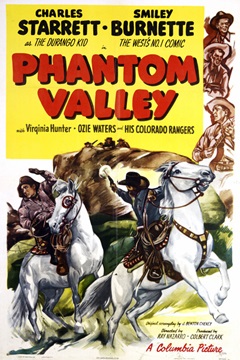 Another frontier town is in trouble.
Another frontier town is in trouble.
Sherriff Jeff Conner (Jack Rockwell) is having trouble ridding his town of outlaws so his son, Larry, (Mickey Kuhn) writes a letter to his hero to ask for help. He addresses the letter to “Durango Kid, Texas.” That’s all it takes for Steve Randall (Charles Starrett) and his sidekick, Smiley Burnette, to show up in town.
Steve and Smiley apply to be deputies but Sheriff Conner explains that someone is circulating a petition to get him fired. Steve dresses up as the Durango Kid and pressures the citizens to give the Sheriff another chance. Realizing that the Durango Kid is making them look bad, the outlaws decide to dress up one of their own as Durango and make the Kid look bad. With the town turning on Durango, will Durango and Smiley be able to save Sheriff Conner from an assassination attempt?
This Durango Kid film is different from the rest of the series in that, for once, Steve is hired to be a deputy instead of a sheriff. This really is Sheriff Conner’s story, as he tries to win the respect of the town and keep its citizens safe, even while his own brother (Ed Cassidy) is working with the outlaws. There are all the usual horse chase and shootouts but this time, Durango and Smiley are mostly around to provide support to a man who is trying to do the right thing. B-western fans will enjoy it.
Smiley sings a few songs, as always. This time, musical accompaniment is provided by Merle Travis and his Bronco Busters.
